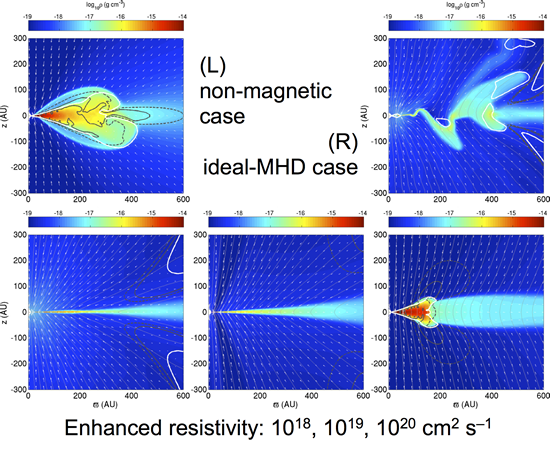研究成果藝廊 > 天文物理理論與觀測整合研究計畫(CHARMS)
研究成果藝廊
天文物理理論與觀測整合研究計畫(CHARMS)
| Disk Formation Enabled by Enhanced Resistivity |
|
圖片來源: Ruben Krasnopolsky

Snapshots of 2D density distributions of models with different mangetization, at a representative time of 1012 sec. The white solid lines indicate positions of the radial infall sonic transition at –0.2 km s–1, and the dark gray solid lines mark the positions with 100% Keplerian rotational support. The top panels show two close-to-extreme cases: the non-magnetic case with no magnetic breaking (left) and the ideal-MHD case where no rotationally supported disks form (right). The bottom panels show magnetic cases but with enhanced resistivity. The case with 1020 cm2 s–1 forms a rotationally supported disk on a scale of ~ 100 AU.
|
Disk formation in magnetized cloud cores is hindered by magnetic braking. Previous work has shown that for realistic levels of core magnetization, the magnetic field suppresses the formation of rotationally supported disks during the protostellar mass accretion phase of low-mass star formation both in the ideal MHD limit and in the presence of ambipolar diffusion for typical rates of cosmic-ray ionization. Additional effects, such as ohmic dissipation, the Hall effect, and protostellar outflow, are needed to weaken the magnetic braking and enable the formation of persistent, rotationally supported, protostellar disks. In this paper, we first demonstrate that the classic microscopic resistivity is not large enough to enable disk formation by itself. We then experiment with a set of enhanced values for the resistivity in the range η =1017 – 1022 cm2 s−1. We find that a value of order 1019 cm2 s−1 is needed to enable the formation of a 102 AU scale Keplerian disk; the value depends somewhat on the degree of core magnetization. The required resistivity is a few orders of magnitude larger than the classic microscopic values. Whether it can be achieved naturally during protostellar collapse remains to be determined. (Krasnopolsky, Li, & Shang 2010, ApJ, 716, 1541) |
 asiaa.sinica.edu.tw 媒體連絡: epo
asiaa.sinica.edu.tw 媒體連絡: epo asiaa.sinica.edu.tw
asiaa.sinica.edu.tw